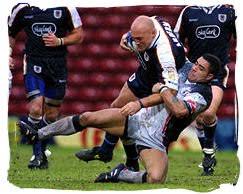Tackling persistent shoulder injuries in Rugby 
By Dan Morris, B.Sc (Hons), GSR
Senior Physiotherapist, Drummond Clinic
Rugby injuries are getting more and more prevalent despite the advances in technology and sports sciences/rehabilitation – and injuries are occurring more often…
A large reason for this is due to the fact that Rugby players are becoming much more athletic. For example, the average weight of a back has increased 10-15kg with a reduction of 5% body fat. This has resulted in bigger, leaner and stronger athletes. The issue with this is that these players now need a greater force applied to them in order to slow them down! To make matters worse, if you are not the fitter, stronger and faster athlete, your injury risk is the one that is significantly increasing!
Injury Recurrence
The Rugby shoulder is becoming a big issue and an injured shoulder has a recurrence rate of around 75% according to some studies. They tend to be a result of tackling and/or being tackled.
So why are shoulder injuries recurring so much? Well, a lot it seems to be due to certain aspects of rehabilitation being sub optimal. We tend to see a reduction in the onset of TIMING within the shoulder when a tackle is performed.
Losing Position Sense
The complicated bit – stay with us here! New research is theorising that this lack of activation of the shoulder is potentially due to a reduction in JOINT POSITION SENSE (JPS). Now this is exactly what it says it is, the ability to perceive the shoulder in space at a given angle. If the nervous system has an inability to perceive where the shoulder is in space, it is very unlikely to recruit the muscles required at their optimal rate within that range in order to protect the joint.
Now, the interesting this is that injured Rugby players tend to lose there ability to sense their joint in a mid range position, meaning the muscles are less likely to stabilise in this position. Further from this, repeated tackles reduce JPS in an out of range position.
Relevance
So why is this relevant? Well, if a previously injured shoulder has poor muscle patterning in an inner range position, it will bypass this somewhat. In an outer range position, we are relying on our passive structures (ligaments and connective tissue) to relay information back to the nervous system in order to fire the muscles and protect. Now, the issue above shows that this outer range JPS reduces with repeated tackling. This out of range feedback is the last point of call before major traumas and dislocations are likely to occur!
Basic Test
So if you have a previously injured shoulder, test your joint position sense. Lie on your back and ask a friend to take your non-injured shoulder into a certain position with your eyes closed. Now, try to replicate this position with your opposite shoulder. Is there a difference? You can now use this same test to start practicing this and retraining this deficit in your JPS.
